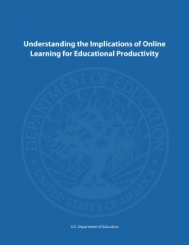Promoting Grit, Tenacity, and Perseverance - U.S. Department of ...
Promoting Grit, Tenacity, and Perseverance - U.S. Department of ...
Promoting Grit, Tenacity, and Perseverance - U.S. Department of ...
You also want an ePaper? Increase the reach of your titles
YUMPU automatically turns print PDFs into web optimized ePapers that Google loves.
Draft<br />
such as task definition, planning, monitoring, deliberation over findings, <strong>and</strong> adaptation <strong>of</strong><br />
approach. Design thinking is a pedagogical paradigm that emphasizes the processes necessary for<br />
innovative design—brain storming, using imagination, collaboration, prototyping, feedback, <strong>and</strong><br />
iterative development (Carroll et al., 2010). Design thinking supports perseverance through the<br />
development <strong>of</strong> important mindsets <strong>and</strong> learning strategies, as students learn to “fail early <strong>and</strong><br />
<strong>of</strong>ten” <strong>and</strong> use feedback to iteratively improve a product.<br />
Some schools are beginning to implement PBL with the intention <strong>of</strong> fostering grit, tenacity, <strong>and</strong><br />
perseverance, among other competencies. One such school is Envision Charter School<br />
(http://www.envisionschools.org/) in San Francisco. This school serves a diverse student<br />
population (78% black <strong>and</strong> Latino, 60% first-generation college bound, <strong>and</strong> 61% qualifying for<br />
free or reduced-price lunch). A key foundation <strong>of</strong> the charter is PBL, culminating in a college<br />
success portfolio produced during the senior year. Envision, from its inception, saw the pursuit<br />
<strong>of</strong> long-term goals <strong>and</strong> all the necessary skills that dem<strong>and</strong>s as the most critical elements <strong>of</strong><br />
learning. Time-management <strong>and</strong> persistence through long-term projects are central in their<br />
model. While formal evaluation data is not yet available, Envision reports that 98% <strong>of</strong> their<br />
graduates go to college <strong>and</strong> 91% remain in college.<br />
Quest to Learn (http://q2l.org/) is a network <strong>of</strong> two schools in Chicago <strong>and</strong> New York City that<br />
share much <strong>of</strong> the same philosophy, placing a strong emphasis on design thinking. Founded on<br />
principles <strong>of</strong> game design, the activities in these schools utilize the motivating qualities <strong>of</strong> game<br />
play to encourage creativity <strong>and</strong> deep cognitive engagement. What aligns their philosophy<br />
closely with PBL is their view that the best learning happens through a process <strong>of</strong> trying, failing,<br />
<strong>and</strong> iterating. In fact, there is an expectation at these schools that assignments almost never be<br />
turned in just once. The process <strong>of</strong> getting feedback, from both teachers <strong>and</strong> peers, before<br />
persisting in creative ways to improve one’s work, is seen as a critical in learning <strong>and</strong> developing<br />
as a student.<br />
Beyond these models, there are a number <strong>of</strong> schools throughout the country that are developing<br />
their own models. The Middleshift Initiative, funded by the Raikes Foundation, has begun to<br />
build a resource network <strong>of</strong> such programs to foster what they call “agency”—a combination <strong>of</strong><br />
productive mindsets <strong>and</strong> learning strategies. Middleshift convened a conference in fall <strong>of</strong> 2012 in<br />
which practitioners, researchers, <strong>and</strong> policymakers met to begin to build a community <strong>of</strong> practice<br />
<strong>and</strong> explore essential design principles.<br />
These models have just begun to emerge in last 5 years or so, <strong>and</strong> touch only a small percentage<br />
<strong>of</strong> schools throughout the country. More research is necessary to refine the models <strong>and</strong> establish<br />
whether they are effective, for whom, <strong>and</strong> under what circumstances.<br />
School reform programs. A third approach is found in reform programs that work with schools<br />
to help them set up learning environments that are supportive <strong>of</strong> perseverance. Darling-<br />
62
















